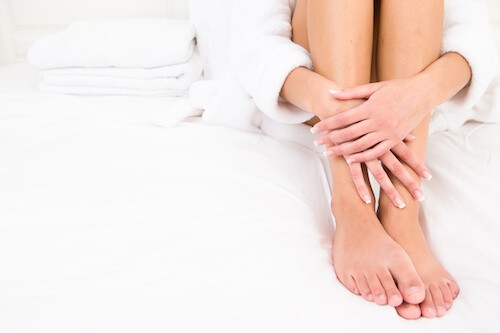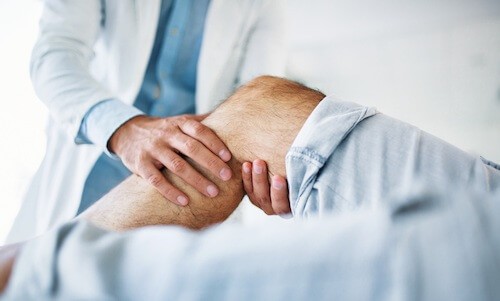Myths and misconceptions about varicose veins and varicose vein treatments cause many people to delay care. This results in needless suffering and limits people’s ability to live life to the fullest. Here we present the second installment of our 2-part series (see Part 1 here) in which we dispel varicose vein myths so that more people can get the care they need to live healthy, active, fulfilled lives.
MYTH #6: Treatment for Varicose Veins is Painful
When painful vein stripping surgery was the only available treatment option, this was true. Recovery from vein surgery was an arduous and painful process with risks for bleeding, infection, blood vessel injury, chronic swelling, and potential injury to nearby structures. Similarly, laser surgery required lengthy healing times with the use of compression stockings and often resulted in damage to the vein walls due to the high temperatures used in the procedure[1].
One of the many advantages of modern treatments is that they have done away with these issues. As a result, they require only local anesthesia, which also eliminates the hazards of general and spinal block anesthesia. Patients who receive VenaSeal™ treatment, a minimally invasive procedure that uses a single injection point to administer a medical grade adhesive that closes off varicose veins, report little to no pain[2]. And most modern procedures require virtually no downtime for healing and no need for compression stockings. This means you can resume your normal activities the same day of the procedure.
MYTH #7: The Veins Will Always Come Back After Treatment
The risk of recurrence of varicose veins is a significant problem following conventional vein surgeries such as vein stripping and ligation. In over half of these procedures varicose veins recur, leaving patients in the same predicament they originally sought help for. In one study, 62% of patients who had ligation surgery developed recurrent varicose veins[3]. With those odds, it’s easy to understand how varicose vein patients can feel discouraged about their chances and reluctant to undertake a varicose vein procedure. However, the risk of recurrence has been significantly reduced with newer, minimally invasive treatments, such as VenaSeal™.

MYTH #8: Insurance Does Not Pay for Varicose Vein Treatment
Many people still think that varicose vein treatment is expensive and requires major surgery or that their insurance won’t cover it because it’s considered to be merely a cosmetic issue. These misperceptions are unfortunate as they discourage people from seeking treatment and, as a result, they suffer needlessly.
The good news is most insurance plans cover varicose vein treatment for symptomatic patients. At Empire Vein & Vascular Specialists, we accept most health insurance plans, including Medicare, PPs, HMOs, and IEHP. The vast majority of our patients have the cost of their vein treatment covered by insurance.
Myth #9: Why Bother Getting Treatment if I Still Have to Wear Compression Stockings After Treatment?
This myth persists due to a lack of knowledge and awareness of new procedures. In the past, vein stripping surgery and laser surgery required wearing compression stockings for 2-4 weeks while the legs healed, and many doctors recommend that their patients wear compression stockings as a preventative measure to decrease symptoms associated with varicose veins.
Varicose vein treatment has undergone a revolution in recent years. Innovations in materials and techniques have resulted in vein treatments that are much less disruptive to veins and surrounding tissues of the legs and much quicker and simpler to heal. Modern vein treatments are safe, effective, minimally invasive techniques that have drastically reduced healing time, which means little to no need for the use of compression stockings that was required with both stripping surgery and laser vein surgery. With these procedures, many varicose vein patients can resume their normal activities the same day of their treatment[4,5].

Myth #10: I Am Going to Have Scars
Conventional vein stripping surgeries required long incisions and resulted in a lot of collateral damage to the tissues and structures of the legs. These procedures left significant scarring and oftentimes left the skin permanently discolored. Cosmetically, this led some patients to feel undecided as to which they preferred, their unsightly varicose veins or their equally unsightly surgical scars.
The newer generation of minimally invasive varicose vein treatment procedures has done away with the extensive scarring associated with stripping surgery. Just a few tiny incisions and one simple injection of medical grade adhesive are all that’s needed to get the job done. No sutures or staples, just a Band-Aid placed on your leg after treatment and you’re on your way! And the incisions heal quickly with absolutely no scarring.
Myth #11: Surgery Is More Dangerous Than Having Varicose Veins
This myth was developed because complications and adverse events following vein stripping surgery were numerous and common. Infection can occur at the surgical site, which can develop into septicemia (blood poisoning)[6]. Nerve damage is another risk associated with stripping surgery and when this happens patients may experience numbness or other sensory disturbances[6]. Additionally, the risk of developing a blood clot, or thrombosis, increases 8-fold. In one study, 28% of patients who underwent open vein stripping surgery for varicose veins experienced postoperative complications and 14% experienced significant side effects or postoperative complications[6].
By comparison, next-generation varicose vein procedures are highly safe with minimal complications. A study evaluating the safety of the VenaSeal™ procedure saw no serious adverse events and only minor side effects that included minor bruising at the incision sites and mild inflammation that healed on its own within a few months[2].

Myth #12: Everybody Has Some Leg Pain
This myth may stem from the common belief that pain is a natural part of the aging process and simply a fact of life as we get older. Or, it could derive from the misconception that varicose veins are merely cosmetic (see Varicose Vein Myths, Part 1). However, both of those schools of thought are far from the truth.
Simply put, chronic leg pain is not normal or common and it shouldn’t be accepted as such. Certainly, if your leg pain is from a small cut or bruise or a minor strain or sprain and heals on its own without incident or recurrence there’s probably nothing to worry about. But, any other kind of leg pain or leg pain that persists should be evaluated by a qualified health professional who can provide an explanation, diagnosis, and recommended treatment.
The fact is problems that can cause leg pain are many. You can find a partial list on the Mayo Clinic website[7], which devotes an entire page to common causes of leg pain, including dozens of potential causes, among them varicose veins. And because some of the causes of leg pain can be quite serious, including varicose vein pain, the earlier the problem is addressed the better.
To learn more about your vein health and which vein treatment is right for you we invite you to schedule a free consultation at Empire Vein & Vascular Specialists. All of our physicians are board-certified vascular surgeons who specialize in helping people like you.
Empire Vein & Vascular Specialists is the top provider of VenaSeal™, the leading outpatient varicose vein treatment, in the USA. Schedule a free consultation today by calling 1-800-827-4267 (1-800-827-4267).
If you missed the first part of this two-part series, click here to see Varicose Vein Myths Part 1.
References
- Pulsed-dye laser treatment of leg telangiectasia: with and without simultaneous sclerotherapy. J Dermatol Surg Oncol, 1990. 16(4): p. 338-44
https://www.ncbi.nlm.nih.gov/pubmed/2324370 - Early results of an Asian prospective multicenter VenaSeal real-world postmarket evaluation to investigate the efficacy and safety of cyanoacrylate endovenous ablation for varicose veins. J Vasc Surg Venous Lymphat Disord, 2021. 9(2): p. 335-345.e2
https://pubmed.ncbi.nlm.nih.gov/32387378 - Causes of varicose vein recurrence: late results of a randomized controlled trial of stripping the long saphenous vein. J Vasc Surg, 2004. 40(4): p. 634-9
https://pubmed.ncbi.nlm.nih.gov/15472588 - Need for adjunctive procedures following cyanoacrylate closure of incompetent great, small and accessory saphenous veins without the use of postprocedure compression: Three-month data from a postmarket evaluation of the VenaSeal System (the WAVES Study). Phlebology, 2019. 34(4): p. 231-237
https://pubmed.ncbi.nlm.nih.gov/30227791 - Endovascular radiofrequency ablation for varicose veins: an evidence-based analysis. Ont Health Technol Assess Ser, 2011. 11(1): p. 1-93
https://pubmed.ncbi.nlm.nih.gov/23074413 - Long-term outcome of open surgery in CVI patients concerning postoperative complications, perioperative hemodynamics and clinical efficacy, Part I. Clin Hemorheol Microcirc, 2018. 70(4): p. 399-411
https://pubmed.ncbi.nlm.nih.gov/30320568 - Leg pain. Available from:
https://www.mayoclinic.org/symptoms/leg-pain/basics/causes/sym-20050784